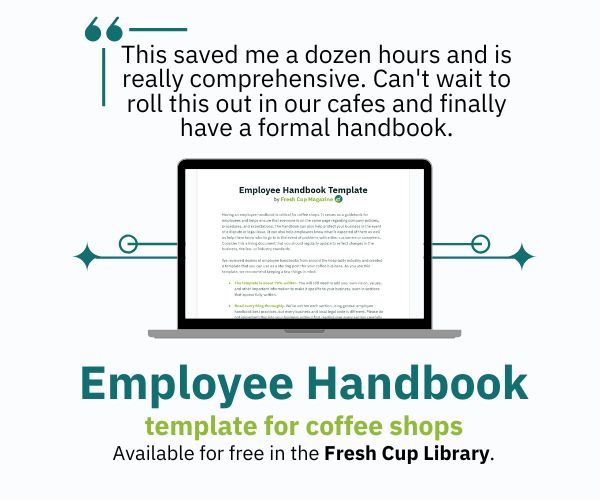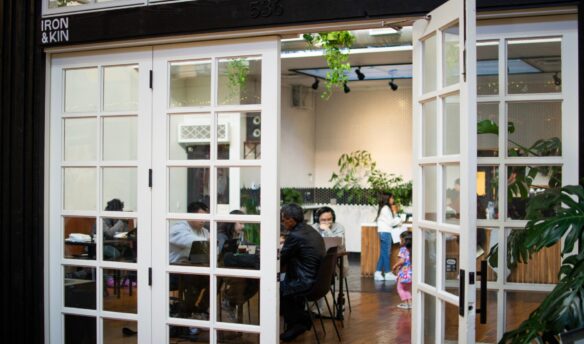Photo courtesy of Michelle Bhattacharyya
For more than a decade, Michelle Bhattacharyya has focused on the intersection of corporate and public good. Having worked at the director-level at organizations including NYC Business Solutions, Social Accountability International, and Global Living Wage Coalition, and now the CEO of On-Up LLC, dedicated to creating incentives for employers to pay living wages, Bhattacharyya has carved her career out of the foundational belief that sustainable change can be achieved when business works together with social and environmental moments.
Set to deliver a talk at the upcoming Re:co Symposium on “Driving Toward Living Wage and Living Income: An Action Oriented Path to a Sustainable Industry,” Bhattacharyya connected with Fresh Cup to discuss a living wage in the specialty coffee industry, advice for café owners, and the long-term benefits of a standard living wage across sectors.
Fresh Cup : What sparked your interest in labor issues and policy?
Michelle Bhattacharyya: Honestly, my interest has always been at the intersection of the for-profit, nonprofit, and public sectors. It always seemed to me that to achieve sustainable change for a better world, we would have to have a variety of stakeholders commit to a solution that worked for everyone. Labor issues were an obvious fit. And while I was working as Director of Operations at Social Accountability International, home of the SA8000 Certification, I really started to focus in on how living wage provided the ideal issue to pull together diverse interests with shared benefits for all actors, and in a way that could impact most of the Sustainable Development Goals that we have today.
FC: What is a living wage in the year 2020? How has it changed in the last decade, and how do you think it will change in the next decade—what past, current, or emerging factors do you think will affect it?
MB: A living wage is really never stagnant or universal in terms of value. It is, as defined by the Global Living Wage Coalition (GLWC), “The remuneration received for a standard workweek by a worker in a particular place sufficient to afford a decent standard of living for the worker and her or his family. Elements of a decent standard of living include food, water, housing, education, health care, transportation, clothing, and other essential needs including provision for unexpected events.” This means that a living wage varies based on where in the world you are and changes every year adjusting for inflation in that specific location. And a living wage is important for both supply chains and an employer’s own workers. Often these elements are separated, but really it is a concept that works best when it becomes part of an overall culture.
So if you are looking to make sure that baristas, a major contact point to consumers, are earning a living wage and can communicate the concept in order to drive customer support for living wages, you’ll want to look at the cost of living where their work is located. In a scenario where a barista works in Portland, Oregon, for example, a living wage that aligns with the definition above would be $20.16 per hour (MIT Living Wage Calculator + 5% for unexpected events). Tips can be counted toward that amount, but only if they are regular and dependable. And these estimates assume you are providing those baristas health insurance. The picture is altogether different in Memphis, Tennessee, for example, where living wage if insurance is provided would be only $15.26 per hour because the cost of living is so much lower.
Supply chains create quite a different set of living wages, depending on the location. In Guatemala the monthly living wage for the rural central departments today is GTQ 2,981 or US $387, up from GTQ 2,689 or US $359 three years ago [per a GLWC study]. It is a figure based on the concept of the cost of a decent yet basic life, and as that is locally specific and ever evolving, so is the living wage around the world.
Living wages are not only time specific, but they are also place specific. Not all supply chain locations weigh in at the same living wage just as different locations across the U.S. or Europe would have different living wage levels. The GLWC estimated monthly living wages for Northwest Nicaragua at C$8,048 or US $265 (in 2017) and in Rural Kenya at KSh 13,943 or US $138 (in 2016). The important thing to note is that although the value of a living wage changes with time and place, the concept is consistent.
Currently, we are seeing an upswell in interest around the world in paying a living wage because businesses across the supply chain are beginning to understand that paying a living wage has benefits that secure the long-term sustainability of an industry. Ensuring that prices cover living wages offers a way to combat the coffee price crisis for example. Workers are often more productive and have fewer health issues as they are able to afford proper nutrition, medical care, and don’t have to work multiple jobs when they earn a living wage. The recognition of these benefits feeds an ever-growing movement to ensure that workers earn a living wage around the world. And as more and more companies start to really attack the issue of incredibly low wages for their own workers and throughout supply chains, industries like coffee will move toward a tipping point where those slow to respond will become obsolete or be forced to follow the industry trend toward a decent living wage.
Living wage is one of those rare goals that when achieved, benefits workers, business, and communities. This beneficial nature for a variety of stakeholders means that it is an achievable goal if leaders across industry continue to be willing to take the first steps and provide examples for others to follow. It creates a scenario of incentives where in 20 years, living wage payment will be the norm, and the impacts in terms of sustainability will be significant, not only in terms of eradicating poverty and stabilizing prices, but also by contributing to less global social upheaval and more stable economies overall.
FC: Why is coffee a key industry when discussing the living wage?
MB: Coffee, and specifically specialty coffee, is a really important industry to start proving the benefits of a living wage. This is due to the fact that roasters and coffee shops are often directly connected to the farmers from whom they source. Information can flow more transparently and price increases can be followed to workers and explained to an already discerning customer that values sustainability and living wages. Coffee also provides a setting for a living income to be considered for smallholder farmers that are struggling themselves to make ends meet.
This primes coffee to set an example of how living wages really can result in overall benefit to all stakeholders. It sets a perfect stage for proof of concept at a large scale. And the coffee price crisis creates an obvious example of why this could be important and valuable that provides motivation for a precompetitive collaboration on living wages and living incomes.
FC: What is your advice for café owners when it comes to providing a living wage to employees? Does that advice change when it comes to coffee workers at origin, or elsewhere in the supply chain?
MB: My advice is to get your own house in order first for your own employees. And don’t be daunted if you are far off the mark. Just start moving steadily toward the goal of a living wage by doing an assessment. Consult the MIT living wage calculator for your location and understand what a living wage is for a worker in a family with two children and two working parents. Then add in 5% for unexpected events to fit with the global definition of living wage. If you pay for health insurance for your workers, you have your estimate. If you don’t, take a look at the health exchanges and get an estimate of what a silver-level plan costs on the open market with an income that MIT states as the cost of living for the family make-up we just described. In this way you can include expected government subsidies. Add that amount to the MIT estimate, and you have a target for your staff.
Next, you want to understand how much everyone is dependably taking home in tips so you can add that to the pay you are giving. Track this over time. Ask everyone to report it in for you. This should give you a good sense of the gap to a living wage. If you find you are short, and that a pay increase may be necessary to cover the additional costs of paying workers a living wage, then start talking to your customers. Ask them if they would be willing to pay whatever you calculate you would need to charge extra to make sure everyone working at the cafe can support themselves and their families. Get comfortable with what is possible and raise wages as quickly as you can to meet your goals. Have a clear timeline, and track how it impacts your business. You may be surprised but if your staff is happy and communicating why prices may change with your customers, you may see profits increase.
Then move to the supply chain, having learned from this experience. Think about whether the price you pay for the coffee you buy actually makes a living wage even possible. Ask your farmers what percentage of the price of coffee you buy is accounted for in labor. If it is, say, 70%, then ask what they are paying workers and compare that figure to living wage estimates available through the Global Living Wage Coalition for example. If they aren’t available, work with others to move forward in finding this research as a larger collaboration for your sourcing locations. If you are 20% short of a living wage, you can build a plan toward a 20% increase in price on the 70% of the price of coffee that is paying for labor. And talk to your producers. Make sure you can create a scenario where you know this extra money is going to workers. You can roll it out in the same way you did for your own employees. Talk about it to your customers and market the idea. Let the living wage work for your business and your customers support your move.
FC: What else do you want the specialty coffee community to know about a living wage?
MB: Although you can move on living wage today, we will all benefit from greater collaboration. Get actively involved in supporting living wages across the coffee sector and share your stories and your experience.
















